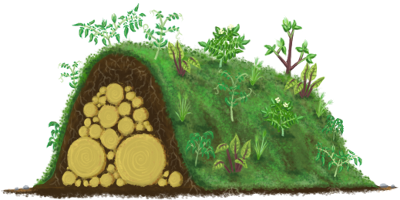Over the summer I came upon a great idea from a man at my church named Stan Smothers, the idea was simple... one female rabbit with heavy breeding could in one year produce as much meat as a cow, and he puts it "They come in meal sized packages." I found this hard to believe so I looked it up and it’s a true fact. Wikipedia stated around 800 offspring. But you never know. Stan's old college had a self-sustaining ecosystem project using rabbits, a garden, and a worm bed. The system went like this... a rabbit cage with hardware cloth for flooring perched over a worm bed next to a vegetable garden would with a little catalyzing take care of its self. The droppings from the rabbits fall threw the floor into the compost pile (rabbit pellets are like solid gold for a garden). Then once mixed up by the worms it can be shoveled into the garden to grow vegetables. You eat the produce and then the scraps get fed back to the rabbits,and occasionally when the cage gets crowded you eat a rabbit. Of course, the rabbits need more to eat than scarps from the garden, so I figured they could eat the grass around my house. (Rabbits can eat almost anything plant material wise, as long as its not poisonous). I researched this and put it into action. The missionary Keith Larrimore at Equip with whom I was working at that time had informed me, that mostly you need to use scraps in third world countries as opposed to fresh building materials. So I dove into my father’s scrap lumber pile and in a day or two had a very nice rabbitry with some help from my brother Aaron. The rabbitry stood four feet off the ground with a box below for catching the droppings and hardware cloth for floor and sides and an air tight breeding box filled with straw in the back. I had a steel pot for feeding the rabbits some pellets when needed, and two water feeders so they could stay hydrated. I bought two large snow-white New Zealand rabbits and kept them in the cage and they seemed to like it. They were more like pets than livestock. Then my brother Aaron who helped me a lot during this process found two more rabbits - a New Zealand male and a mystery brown female rabbit who turned out to be a mutt of some very rare and very valuable species of meat rabbit - Chinchilla, Champagne d'Argent, and Californian. I named the male Buck as he was the tamest and let him run around in the yard. He followed me around like a dog on a farm and used him to breed the other rabbits. In a month’s time the brown rabbit gave birth to eight baby rabbits, five of which survived infancy and are now rather large and crowding the cage, and one white female just gave birth yesterday to a litter of naked little baby rabbits sitting in a white nest of the mother,s fur. No major problems have occurred during the whole project other than a bear break in or two. The manure doesn’t smell too bad, because its just dry little pellets. That is unless it gets wet, which it does under the water feeders, yuck. I take the manure and place it on my Hugelkultur garden or permaculture garden (richsoil.com/hugelkultur) which is just a pile of rotting logs and debris that break down over 20 years to release nutrients and create a underground sponge, like how under the forest floor its always wet. It also adds benefits like... how the dirt partial compaction is less on a domed structure rather than a flat mono-crop garden allowing for less strain on the roots and a variance in sunlight for different plants depending on the bed’s position to the sun. I will plant crops on my garden during the spring that benefit each other such as carrots, that draw nutrients from down deep for the plants surrounding them due to the long tiny root they send way down. I have completed the Hugelkulture garden, but due to it being winter I won’t start the cycle until spring planting season. As well, the rabbits have already eaten every green weed, grass, and plant I could give them. They cleared out a plot of impenetrable weeds behind the chicken feed house (my father raises chickens on our farm) so this winter the rabbits are eating into a project deficit at 10$ a bag of feed. The total project has cost 75$. I will post a photo album of my project when I can; my computer is not synced with my printer at the moment. I did all this with the thought of one day using a process similar to this in the mission field if it is God’s will, or even in some small way, use it to His glory.
- Romans 8:28 And we know that in all things God works for the good of those who love him, who have been called according to his purpose.
In Christ
David Greene


No comments:
Post a Comment